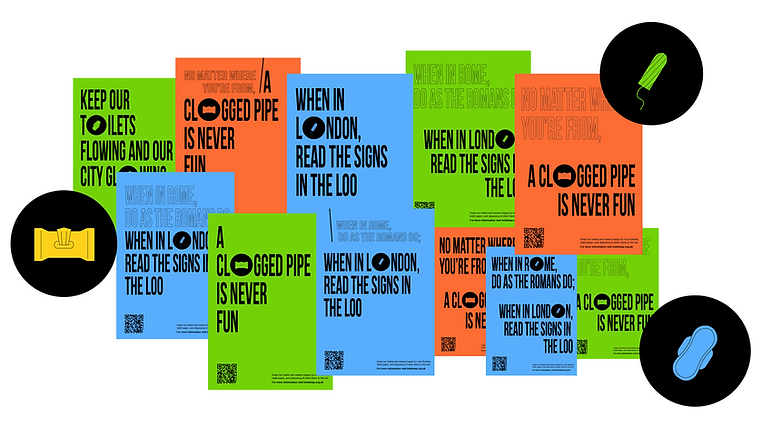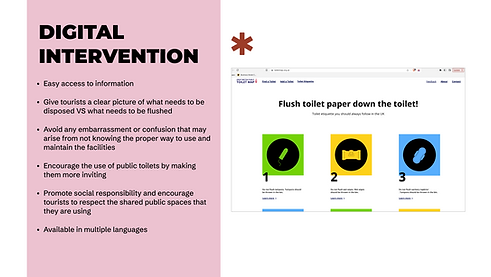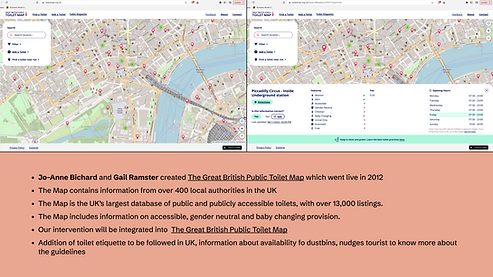
PROJECT BRIEF
ADOPTING RESPONSIBLE FLUSHING PRACTICES THROUGH BEHAVIORAL DESIGN
OBJECTIVE
To Increase information and awareness about bathroom etiquette in the UK by nudging
tourists towards adopting responsible flushing practices that protect the environment and improve hygiene to reduce sewage blockages and maintenance costs.
MY ROLE
User Researcher
Service Designer
Communication Designer
Storyteller
METHODS & TOOLS
Research
Nudge
User Persona
Journey Mapping
Stakeholder Mapping
Systems Mapping
Concept generation
Prototype & Testing
TIME FRAME
5 weeks
THEMES
Public Sector
Behavioral Design
Service Design
Context
Access to safe water, sanitation, and hygiene is not only a fundamental human right but also essential for ensuring the health, well-being, and overall development of individuals and communities. However, despite significant efforts and progress in recent years, there are still billions of people worldwide who lack access to these basic services.
To meet the United Nations' Sustainable Development Goal 6 of universal access to water and sanitation by 2030, the current pace of progress needs to quadruple. This urgency arises from the growing challenges posed by rapid population growth, urbanization, and the increasing water demands from various sectors such as agriculture, industry, and energy. These factors further strain already limited water resources and pose a threat to the sustainability of water systems.
Addressing the complex issues of water, sanitation, and hygiene requires more than just technological solutions. It calls for a holistic approach that encompasses social, cultural, economic, and political dimensions. This involves engaging communities, raising awareness, promoting behavior change, and fostering sustainable practices.

"How might we increase information and awareness about bathroom etiquette in the UK by nudging tourists towards adopting responsible flushing practices that protect the environment and improve hygiene to reduce sewage blockages and maintenance costs?"
Our interventions were designed to educate and nudge tourists towards proper toilet etiquette. We developed three interventions to target different touchpoints and engage tourists effectively
Intervention 1- Information Dissemination

The first intervention focused on information dissemination. We created engaging communications and branding materials that used comedy and fun visuals to educate tourists about the proper flushing practices in London. These branding touchpoints were strategically placed in airports and touristy locations, ensuring widespread visibility. By reducing the taboo and stigma associated with this issue, we aimed to encourage conversations and promote awareness about responsible toilet practices.
Intervention 2- Digital Intervention
The second intervention leveraged digital technology. We integrated essential information into the Great British Toilet Map, a popular resource for tourists. We created a dedicated webpage accessible through a QR code on the map, providing comprehensive guidelines on toilet etiquette, various practices used worldwide, and how to navigate UK's toilets. Recognizing the language barriers, we made the webpage available in multiple languages. This digital intervention not only facilitated easy access to information but also respected tourists' privacy and reduced any embarrassment or confusion they might experience.



Intervention 3- Redesigned dustbins
The third intervention focused on designing a new type of dustbin. These specially designed dustbins had different segregations for various items, including a dedicated slot for wet wipes and a separate compartment for tampons. By encouraging proper disposal and discouraging flushing of inappropriate items, such as wet wipes and toiletries, we aimed to reduce the chances of blockages and damage to the water infrastructure. These dustbins were strategically placed in public toilets, railway and tube stations, airports, malls, and supermarkets, ensuring widespread accessibility and usage.
The third intervention focused on designing a new type of dustbin. These specially designed dustbins had different segregations for various items, including a dedicated slot for wet wipes and a separate compartment for tampons. By encouraging proper disposal and discouraging flushing of inappropriate items, such as wet wipes and toiletries, we aimed to reduce the chances of blockages and damage to the water infrastructure. These dustbins were strategically placed in public toilets, railway and tube stations, airports, malls, and supermarkets, ensuring widespread accessibility and usage.
.png)
Potential Impact
-Saving millions of pounds in maintenance costs
-Reduce the negative impact of clogs and sewage blockages
-Preserve the hygiene and identity of the country - encourage visitors to revisit
Process
Research

We conducted user research through interviews and observational studies:
-
Interviewed 14 people from 8 different countries.
-
Engaged with 8 tourists visiting London.
-
Inspected toilets at multiple locations, including the Royal College of Art, Westfield Shopping Centres, Heathrow Airport, City Airport, tube stations, and various restaurants in the city.
-
Spoke with 3 toilet cleaners
Insights

Identified Stakeholders
The third intervention focused on designing a new type of dustbin. These specially designed dustbins had different segregations for various items, including a dedicated slot for wet wipes and a separate compartment for tampons. By encouraging proper disposal and discouraging flushing of inappropriate items, such as wet wipes and toiletries, we aimed to reduce the chances of blockages and damage to the water infrastructure. These dustbins were strategically placed in public toilets, railway and tube stations, airports, malls, and supermarkets, ensuring widespread accessibility and usage.


Created Personas & Journeys

.png)
